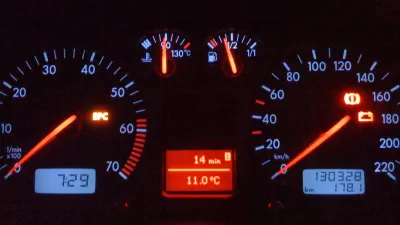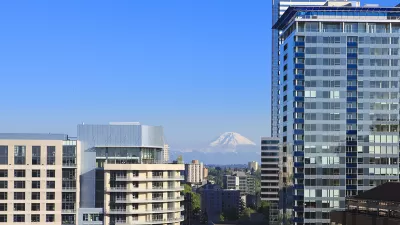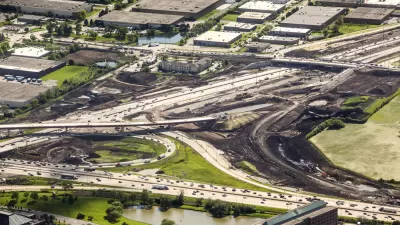U.S. Public Interest Research Group does a state-by-state analysis of the decline in driving in an attempt to determine it's chief causes.

Ryan Holeywell writes that U.S. Public Interest Research Group (PIRG) researchers first looked at what many (e.g. Wendell Cox in his Dec.,2011 blog) may have suspected to be the most common reason attributed to the decline in driving, "the effect of the sluggish economy. Owning a car and paying for gas isn't cheap, so it's logical to assume when times are tough, people would cut back on automobile trips".
"There's no real relationship at all (with the states hit the hardest by the recession)," says Phineas Baxandall, senior tax and budget policy analyst at U.S. PIRG. "When people dismiss it, they say 'it's the economy.' But if that was the case, you'd expect states hit the hardest by the economy to have reduced driving the most. That's not at all the case." (Baxandall also notes that the decline in driving pre-dates the recession by several years.)
In fact, only four states saw per capita driving increases: Alabama, Louisiana, Nevada and North Dakota. From the press release:
- The states with the biggest reductions in driving miles generally were not the states hit hardest by the economic downturn. The majority—almost three-quarters—of the states where per-person driving miles declined more quickly than the national average actually saw smaller increases in unemployment compared to the rest of the nation.
However, Baxandall doesn't dismiss the economic relationship altogether.
"While certainly a contributing factor and an economic rebound could be expected to have some upward lift on driving, the recession does not appear to be the prime cause of the fall-off in driving over the past eight years," Baxandall writes.
According to Holeywell, "(t)he implications of the study could be big. If the decline in driving isn't largely the result of the recession, then transportation planners might want to think twice before assuming driving miles will rebound if the economy picks up."
The Hill's Keith Lang emphasizes that point, pointing to why PIRG titled its report, "Moving Off The Road". Baxandall explains:
“There’s a national decline in driving that is shared by almost every state. It’s time for policy makers to wake up and realize the driving boom is over. We need to reconsider expensive highway expansions and focus on alternatives such as public transit and biking — which people increasingly use to get around.”
If you're looking for a single reason for the decline in driving, this report won't provide it. "All in all, there appears to be no single factor behind the average amount of driving for residents in any given state," according to Baxandall. Whatever the cause(s), "per capita vehicle miles traveled peaked in 2004 and have fallen each of the last eight years, amounting to a 7.4 percent dip in that time", writes Holeywell.
AP's Joan Lowy in The Detroit News on August 30 writes about another study by Transportation Department economists Don Pickrell and David Pace that confirms PIRG's findings.
A flexible chart accompanies the Governing article showing the following data for all 50 states plus District of Columbia:
- per capita Vehicles-Miles-Traveled in 2011,
- % change in per capita VMT, 2005-2011
- peak year for per capita VMT
- peak year annual VMT per capita
FULL STORY: The Mystery Behind America's Decline in Driving

Planetizen Federal Action Tracker
A weekly monitor of how Trump’s orders and actions are impacting planners and planning in America.

Map: Where Senate Republicans Want to Sell Your Public Lands
For public land advocates, the Senate Republicans’ proposal to sell millions of acres of public land in the West is “the biggest fight of their careers.”

Restaurant Patios Were a Pandemic Win — Why Were They so Hard to Keep?
Social distancing requirements and changes in travel patterns prompted cities to pilot new uses for street and sidewalk space. Then it got complicated.

Platform Pilsner: Vancouver Transit Agency Releases... a Beer?
TransLink will receive a portion of every sale of the four-pack.

Toronto Weighs Cheaper Transit, Parking Hikes for Major Events
Special event rates would take effect during large festivals, sports games and concerts to ‘discourage driving, manage congestion and free up space for transit.”

Berlin to Consider Car-Free Zone Larger Than Manhattan
The area bound by the 22-mile Ringbahn would still allow 12 uses of a private automobile per year per person, and several other exemptions.
Urban Design for Planners 1: Software Tools
This six-course series explores essential urban design concepts using open source software and equips planners with the tools they need to participate fully in the urban design process.
Planning for Universal Design
Learn the tools for implementing Universal Design in planning regulations.
Heyer Gruel & Associates PA
JM Goldson LLC
Custer County Colorado
City of Camden Redevelopment Agency
City of Astoria
Transportation Research & Education Center (TREC) at Portland State University
Camden Redevelopment Agency
City of Claremont
Municipality of Princeton (NJ)





























